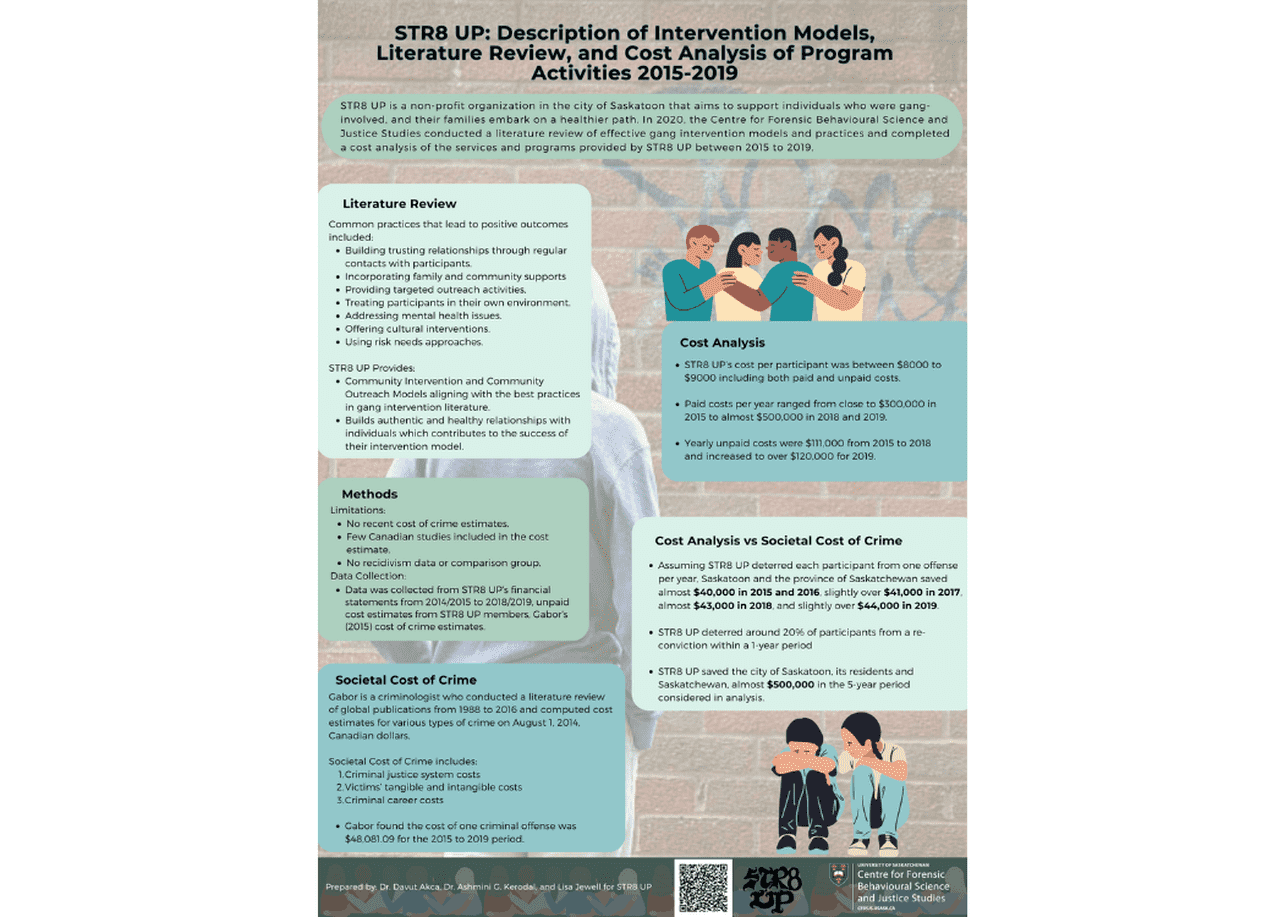
STR8 UP: Description of Intervention Models, Literature Review, and Cost Analysis of Program Activities 2015-2019
In 2012, the Centre for Forensic Behavioural Science and Justice Studies (CFBSJS) conducted a process evaluation for STR8 UP and published a report on the findings. The 2012 report included a literature review on gangs and gang intervention and prevention programs, a description of STR8 UP’s programming, a process evaluation of the program, and recommendations for future activities and services of STR8 UP and gang prevention in Saskatoon.
By Davut Akca, Ashmini G. Kerodal, and Lisa JewellIn 2018, a community-engaged research study was conducted by Dr. Robert Henry to develop a potential community-led provincial street gang strategy through surveys, a community forum, and community consultations (Henry 2018). STR8 UP’s achievements in gang prevention in Saskatchewan were highlighted in the research findings, and based on that, a consensus was reached to acknowledge STR8 UP as the community-based ‘champion’ to develop and implement the Provincial Gang Strategy. In 2019, the Government of Saskatchewan declared its Gang Violence Reduction Strategy and STR8 UP was selected as one of two organizations to deliver outreach, intervention and prevention services to help people leave gangs and reintegrate back into their communities for the upcoming four years in Saskatchewan. With this new role, STR8 UP entered into a new era where two separate, but interconnected, streams of programming are delivered by the organization.
In 2020, the CFBSJS was asked by STR8 UP to assist with their ongoing evaluation efforts. Specifically, it was decided that the CFBSJS would complete: a) a literature review of effective gang intervention models and practices; b) an updated description of STR8 UP’s programs and services; and c) a cost analysis of the services and programs provided by STR8 UP between 2015 and 2019.
Literature Review
In the literature review, we first reviewed the purposes and components of 13 different gang intervention programs implemented across North America. Our review indicated that these programs are developed as alternatives to the traditional suppressive approaches and aimed to reengage participants to their community and adopt prosocial behaviours while desisting from criminal behaviours and gang life. The programs used some common strategies such as developing participants’ life, education, and employment skills through education, counselling, mentorship, and outreach activities. The success of these programs depended on garnering community and family support, taking a multi-disciplinary approach, employing dedicated program staff, partnering with community agencies, using risk-based approaches, integrating cultural components, and taking a phased approach which prioritized the sustainability of behavioural change in the clients. We outlined the measures used to assess the effectiveness of these programs and the outcomes of these programs. The most common measures were risk levels, recidivism/desistance, behavioural change, substance use, school success, and employment. Overall, the programs aimed to change participants’ behaviours in positive ways and promoted a prosocial lifestyle as an alternative to gang life through enhanced attachment to family, school employment, and the community as a whole.
Conclusion
In this report, we reviewed the literature on gang prevention programs, provided program descriptions of STR8 UP’s two concurrent gang intervention programs and a logic model for the STR8 UP program, and presented a cost analysis of the programs provided by STR8 UP between the years 2015 and 2019.
STR8 UP currently provides programs and services under two concurrent models: Community Intervention Model (CIM) and Community Outreach Model. Based upon our review of the literature, STR8 UP’s programs align with the best practices in the gang intervention literature. Specifically, the phased approach in the CIM and COM, relentless outreach activities, broad community support towards STR8 UP, dedication of STR8 UP members to sustainable change, and the integration of cultural programming into both models are the main strengths of STR8 UP. The phased approach in the CIM model of STR8 UP consisting of relentless outreach, transformation, and support and sustainment phases is similar to the Roca program’s stage-based strategy, which focuses relentless outreach and follow-up, transformational relationships, sustainability of behavioural changes, and the engagement of community agencies into the program. The success of models such as Cure Violence and GYRD is partially attributed to the integration of community support into the implementation of program. STR8 UP is a grass roots organization which is supported by a wide range of community agencies and members. Reflective of this broad support, the Provincial Gang Prevention Strategy endorsed STR8 UP as the ‘champion’ for gang intervention in the province and was developed through community consultations and forums.

